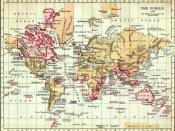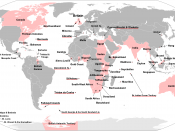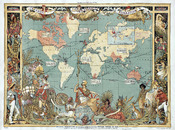The principal distinction between early- and late-modern English is vocabulary. Pronunciation, grammar, and spelling are largely the same, but Late-Modern English has many more words. These words are the result of two historical factors. The first is the Industrial Revolution and the rise of the technological society. This necessitated new words for things and ideas that had not previously existed. The second was the British Empire. At its height, Britain ruled one quarter of the earth's surface, and English adopted many foreign words and made them its own.
The industrial and scientific revolutions created a need for neologisms to describe the new creations and discoveries. For this, English relied heavily on Latin and Greek. Words like oxygen, protein, nuclear, and vaccine did not exist in the classical languages, but they were created from Latin and Greek roots. Such neologisms were not exclusively created from classical roots though, English roots were used for such terms as horsepower, airplane, and typewriter.
This burst of neologisms continues today, perhaps most visible in the field of electronics and computers. Byte, cyber-, bios, hard-drive, and microchip are good examples.
Also, the rise of the British Empire and the growth of global trade served not only to introduce English to the world, but also to introduce words into English. Hindi, and the other languages of the Indian subcontinent, provided many words, such as pundit, shampoo, pajamas, and juggernaut. Virtually every language on Earth has contributed to the development of English, from Finnish (sauna) and Japanese (tycoon) to the vast contributions of French and Latin.
The British Empire was a maritime empire, and the influence of nautical terms on the English language has been great. Words and phrases like three sheets to the wind and scuttlebutt have their origins onboard ships.
Finally, the 20th century saw two...



Interesting read
Never realized how outside factors contributed like the industrial revelution could influence the shape og the english word. Interesting read. Good source of original ideas.
4 out of 4 people found this comment useful.